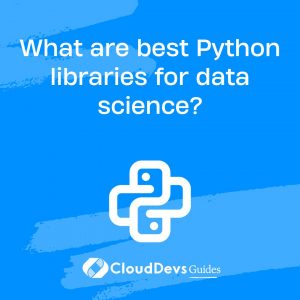Python Q & A
What are best Python libraries for data science?
Python is a leading language for data science, largely due to its extensive library ecosystem tailored for data analysis, manipulation, and visualization. Here’s an overview of the best Python libraries for data science:
- NumPy: A foundational package for numerical computing in Python, NumPy offers support for large multidimensional arrays and matrices, along with mathematical functions to operate on these structures.
- pandas: An essential library for data manipulation and analysis, pandas provides data structures like DataFrame and Series that make data cleaning, aggregation, and exploration efficient and intuitive.
- Matplotlib: A plotting library, Matplotlib is great for creating static, interactive, and animated visualizations in Python. It offers fine-grained control over every aspect of a plot.
- Seaborn: Built on top of Matplotlib, Seaborn is a statistical data visualization library that provides a higher-level, more aesthetically pleasing interface for creating common types of plots.
- SciPy: Complementing NumPy, SciPy is used for more advanced scientific computing. It provides modules for optimization, integration, interpolation, eigenvalue problems, and more.
- scikit-learn: A comprehensive tool for machine learning, scikit-learn offers simple and efficient tools for data mining and analysis. It supports various supervised and unsupervised learning algorithms.
- Statsmodels: For statistical modeling, Statsmodels provides classes and functions to estimate different models and conduct statistical tests.
- TensorFlow and PyTorch: Both are powerful libraries for deep learning. While TensorFlow, developed by Google, is known for its production-ready tools, PyTorch, developed by Facebook, is lauded for its dynamic computational graph which is handy for research purposes.
- Jupyter Notebook: An open-source web application, Jupyter allows you to create and share live code, equations, visualizations, and more, making it a favorite tool for data scientists to document and showcase their work.
Python’s extensive range of libraries caters to every phase of the data science workflow, from data preprocessing and analysis to modeling and visualization. Familiarity with these libraries can significantly streamline and enhance the data science process.

Previously at


Brazil

GMT-3
Senior Software Engineer with 7+ yrs Python experience. Improved Kafka-S3 ingestion, GCP Pub/Sub metrics. Proficient in Flask, FastAPI, AWS, GCP, Kafka, Git



